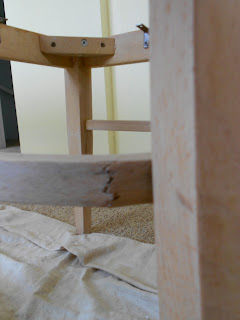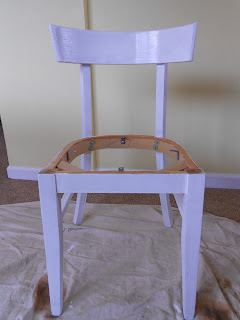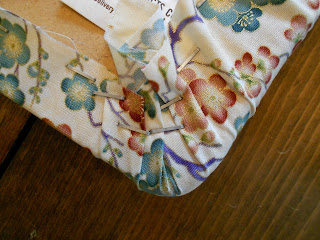How to Make a Button Tab Valence
The work on the study continues, although slightly hindered by various acts of stupidity on my part. For example, I planned the whole project around this fabric,
which I chose because it had two of my main colors in it: the yellow of the walls, and the purple of my recliner. Once I had fallen in love with the fabric ("Wind Symphony" by RJR Fabrics), I took it to the paint store, where I matched the teal and the brick red to use as highlight colors. A week or two later, back to the fabric store I went to buy two yards for... oh, I don't know yet, whatever. But there wasn't any more, and they told me it had been discontinued and they couldn't get it. Great! Now I've planned my whole room around a fabric that doesn't exist.Thankfully, I found it on eBay and ordered two yards. That is, I thought I did. When it arrived and there was only one yard, I got all huffy and self-righteous with the seller, who kindly pointed out that the details on the eBay listing specified that it is sold by the half yard. So "two" means one yard. No wonder it was only half the cost it had been at my local fabric store!
The one yard was enough to cover the two chair seats and get a head start on the valence while I waited for delivery of the other yard I needed. For indeed, I had decided that a valence above the window would look great made of the same fabric.
Twenty years ago I splurged on a pair of really nice (expensive) lace curtains, for which I found no suitable place in the house where we lived for the last 14 years. They were perfect for my study window — not to cover it, but just to hang at the sides and look pretty.
But they needed a valence, don't you think? (Sorry about the poor photo quality; my camera and I are not friends these days.) We splurged on cellular shades that open from either the top or the bottom; here it is all the way up. Just a little hard and straight-sided for my taste, even with the lace panels.
The valence I envisioned would hang from tabs secured by buttons, so I looked around on line and found this site, which gave excellent directions. If you are serious about making a tabbed valence or curtain secured by buttons, you might prefer to go there rather than wading through this chronology.
My first yard yielded enough fabric, after the chair seats were done, to make 18 tabs about 4" wide and 10" long, which I guessed would be plenty. This whole thing was less "planned" than "done by the seat of the pants," but eventually it all worked out.
When the additional fabric arrived, I made sure it was straight by using the old "pull out a thread" trick that I learned in 8th grade sewing class.
It's very tedious, but this way I could be sure that I was cutting exactly on the straight of the fabric. Then I cut it in half lengthwise and seamed the sides together, attempting to match the pattern in the seam by folding/overlapping it the way you would when hanging wallpaper. It was a crap shoot that I'd get it right, and I promised myself that if it wasn't exact, I would not fiddle with it, but would just accept it and go on.
Okay, so not perfect, but not too bad...
This gave me a piece 18" high and 88" long, for a valence over a window that was about 65" wide. I turned in the side seams, using this magical stuff instead of struggling with my fossil of a sewing machine trying to make a hem stitch. You just iron the fabric down with this stuff in between.
Whoever invented this should be sainted.
Then I folded each tab long ways and stitched it, right sides together, across one end and along one side. I used this technique (scroll about half way down the page), which is apparently an old quilter's trick called "strip-piecing," in which you just place one piece next to the one you're working on and keep stitching, rather than that tedious reverse stitching to anchor all the stitches in place at both ends on each separate piece. These were going to end up inside a seam anyway, so they wouldn't really need to be anchored.
They looked like this when I was finished, and all I had to do was cut them carefully apart. The tedious part was turning each one right side out, after clipping the corners so they would lie flat, and pressing them well. Now each tab had one seamed end, one folded side, one seamed side, and one raw end.
Figuring that the finished height of the valence would go from just above the window frame to just below the open (that is, up at the top of the window) shade, I did the math, allowing for the seam allowance at the top (more about that soon) and a 2.5" hem at the bottom. I ripped off the excess fabric to use as a facing at the top, and hemmed the bottom. Oops, I forgot to turn under the 1/2" allowance for the hem, so it's got a raw edge.
Oh well, no one is going to see it (except the thousands of people who read this blog).
Then came the clever part, thanks to the Internet and this site. After searching the whole house to find a 7' piece of floor that wasn't covered in dog hair, I laid out the valence right side up and spaced the tabs on it with the raw edges aligned so that the tabs were facing down. They ended up being about 4"apart, center to center, using 15 tabs. (Okay, so I have three left over... who knows but I might need them some time?)
It's rather difficult to see, so I put a shell on one tab to make it visible.
Then I laid the facing wrong side up on top of the valence and the tabs, and pinned through all layers.
I stitched the whole length of the thing through the facing, tabs, and valence, ending up with something that looked like this with the facing going up, seam at the bottom.
(The facing already had side seams on it, since I had done them before tearing it off.)
When you turn it over to press it, it looks like this, with the raw ends of the tabs secured between the facing and the valence, finished tabs headed in the right direction (that would be up). Remembering the seam allowance this time, I ironed the facing down with that magical Heat Bond so it looked finished.
Then came the fun part, buttons to secure it. I had decided to use a variety of similar-sized buttons in red, purple and green, and had bought a jar of assorted red ones and a jar of assorted purple ones at my local fabric store. I had the green ones already in my button box. (That's one advantage of being an old geezer — you have a really great button collection! And now I have a lifetime supply of red and purple buttons as well.)
These are the ones I chose. They look a little more different in real life, though the green ones are the same.
First folding each tab exactly in half, so they would all be the same finished length, I pinned each one down. Then followed an evening of carefully sewing on fifteen buttons in random order, and voila!
Done! I was a little surprised that it wasn't longer, but I guess I lost a lot of that 88" length with the side hems and the fudging I had to do in order to
And on to the next project, which will be the basket liners. Stay tuned!





























